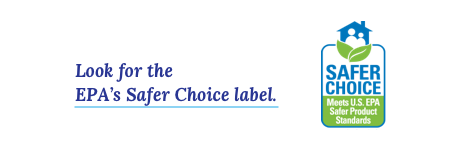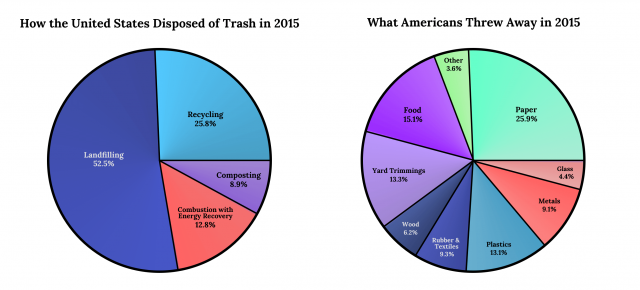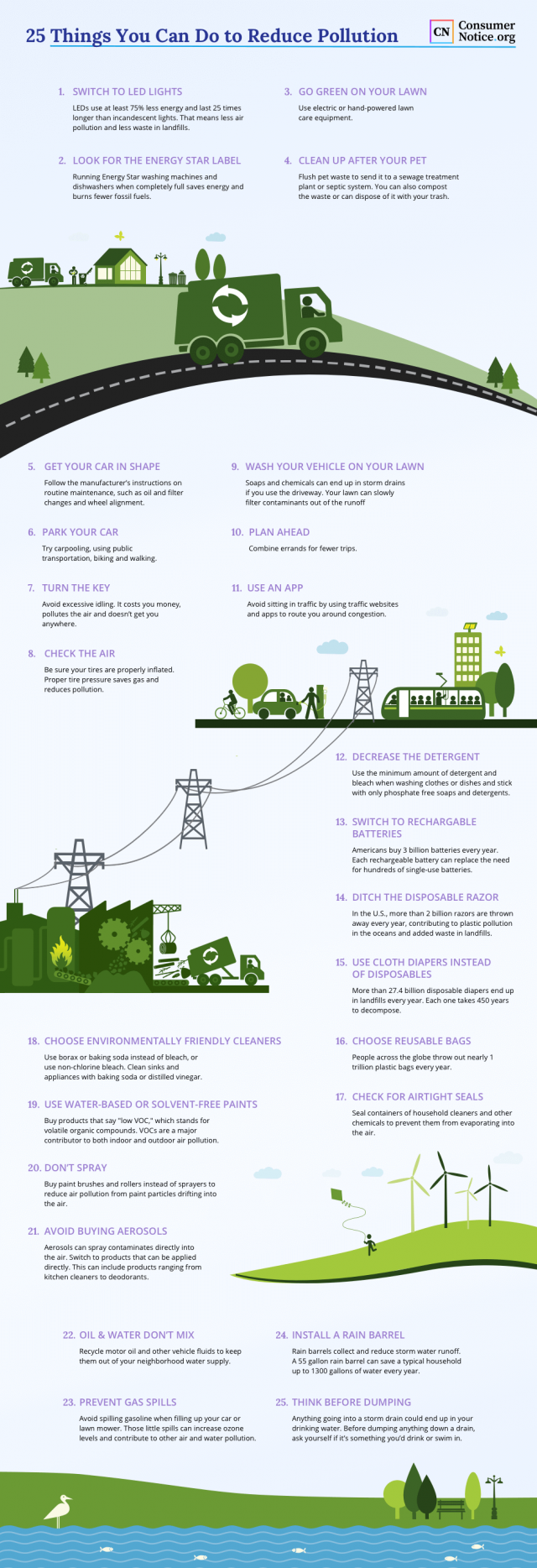A Consumer’s Guide to Reducing Pollution
A surprising amount of pollution starts at home. The car you drive, the household and personal care products you buy, the chemicals and equipment you use to keep your lawn and garden in shape all contribute to water and air pollution. But there are consumer choices you can make that will reduce your environmental footprint.
Consumers play a major role in creating pollution. By some estimates, household consumption is responsible for the majority of air and water pollution in the world.
But by being aware of how you use water, what you toss in the trash, how you drive and how you use energy around the home, you can take some simple steps to prevent a lot of pollution.
While you may think of pollution as a global problem, reducing pollution from your household can have more immediate benefits by improving your neighborhood’s environmental health.

How to Prevent Air Pollution
A 2015 study in the Journal of Industrial Ecology found consumers account for 60 percent of the world’s greenhouse gas emissions.
“If we change our consumption habits, this would have a drastic effect on our environmental footprint as well,” Diana Ivanova, one of the study’s authors, told Science Daily at the time.
Pollution prevention is often a matter of consumer choices. Products that are similar can have much different effects on the environment. The way you use products from your car to lawn care chemicals can significantly affect how much you contribute to air pollution.
The Car You Drive
In 2017, highway vehicles emitted 18.9 million tons of carbon monoxide, according to the U.S. Environmental Protection Agency.
Such emissions play a role in the creation of greenhouse gases, such as carbon dioxide and ozone, that warm the atmosphere. And breathing in higher levels of carbon monoxide decreases the amount of oxygen that reaches a person’s organs and tissues. For a person with heart disease, the health effects can mean a trip to the emergency room or a hospital stay.
Motor vehicles also produce hydrocarbons, nitrogen oxide and particulate matter that also contribute to air pollution.
But the way you drive and the vehicle you choose can cut back on not only emissions but also how much money you spend on gas.
Let’s say you travel 15,000 miles per year and the average cost of gas is $2.83 per gallon. You can save about $700 per year if you drive a car that gets 30 miles per gallon instead of one that gets 20 miles per gallon.
And you can potentially improve gas mileage by about 10 percent if you ditch aggressive driving habits that waste gas, such as speeding, accelerating rapidly and braking.
WHAT YOU CAN DO: Driving more efficiently or driving less can reduce the amount of air pollution you put in the air. Scheduling your multiple home deliveries so they arrive on the same day can reduce pollution from delivery trucks. And keeping your car in tune and its tires properly inflated will improve your gas mileage while reducing the pollution it puts out.
Household Products
Consumer products from kitchen cleaners to shampoos now account for as much air pollution in urban areas as all forms of transportation, according to a 2018 study in the journal Science.
Air pollution from cars, trucks and other types of transportation has been declining as the United States and other countries have passed stricter emission standards. But there hasn’t been the same kind of regulation of air pollution from household products like kitchen cleaners and personal care products.
These products contain volatile organic compounds, also called VOCs. Once these compounds escape into the atmosphere, they can create ozone or other air pollution.
When you burn fuel in your car, only about one one-thousandth of the VOCs in your gas or diesel ends up in the air. But products like cleaners, paints, hair spray and perfumes can pump a larger percentage of their chemical pollutants into the air as they evaporate. And these chemicals can also contribute to indoor air pollution in your home.

WHAT YOU CAN DO: Look for “Low VOC” in products’ labels and make sure containers are tightly sealed to reduce evaporation. Buy products with the EPA’s “Safer Choice” label. These are products that work as well as conventional products but are safer for human health and the environment, according to the agency. You can search for and compare products in the Safer Choice database.
Energy Use
Your household energy use may create twice as much greenhouse gas emissions as your car does in a year’s time. More than 63 percent of the electricity in the United States still comes from burning fossil fuels, according to the U.S. Department of Energy. Improving energy efficiency in your home can help reduce air pollution.

One way to reduce greenhouse emissions through energy efficiency is to use Energy Star certified products. Energy Star is a partnership between the U.S. Environmental Protection Agency and companies and state and local governments to certify energy-efficient products that range from light bulbs to home appliances to industrial equipment.
The typical household spends $2,000 a year on electricity. Using Energy Star products can save you 30 percent or about $575. At the same time, you’ll avoid putting an extra 5,500 pounds of greenhouse gases into the air.
WHAT ELSE YOU CAN DO: Something as simple as turning off the lights when you leave a room can make a huge difference. A 2014 study in the International Journal of Science and Research estimated excessive use of light wastes 2 million barrels of oil every day.
Lawn Care
Motors on lawn and garden equipment are not as clean as the engine in your car. They may be small, but they can pump a lot more pollution into the air. And simply pouring gasoline into their tanks before you crank them up can cause air pollution, too.
Gasoline spills may seem small, but there can be millions every day. Spills contribute to smog and other kinds of air pollution.
WHAT YOU CAN DO: Using electric lawn mowers or using portable gas cans with automatic sealing and shut off features are two quick ways to make your lawn care greener.

Preventing Water Pollution
Polluted runoff and storm water is considered one of the greatest threats to clean water in the United States. In urban and suburban neighborhoods, storm water and melted snow can’t easily soak into the ground. The water runs into storm drains, taking oil, dirt, chemicals and lawn fertilizer directly into streams, lakes and rivers.
WHAT YOU CAN DO: Simple steps around the home make big a difference in reducing water pollution. Pick up pet waste, keep yard clippings out of storm drains and fix car leaks before the next big rain washes oil and other fluids into your local water supply.
Pesticide and Fertilizer Alternatives to Prevent Water Pollution
Using alternatives to toxic pesticides can reduce water pollution. Pesticides include consumer products like Roundup or other weed killers as well as insecticides. But there are natural alternatives.
WHAT YOU CAN DO: Plant native flowers, shrubs and trees that are resistant to pests and can attract pollinators and other beneficial insects. Install bird and bat houses in your yard to combat pesky bugs. A 2018 study in The Science of Nature estimated that globally, birds eat nearly a half trillion tons of insects a year.
Take a similar approach with fertilizers. Nutrients such as nitrates and phosphates in fertilizer can overstimulate water plants and algae. Phosphorus has been called “junk food for algae.” It fuels algae growth, which kills fish and other life in waterways.
WHAT YOU CAN DO: Hire a certified lawn care professional or carefully follow label directions. Too much fertilizer can damage plants and pollute groundwater. Leave grass clippings on the ground after you mow to create a free, slow-release fertilizer. The Peace Corps also offers instructions for making your own less-toxic pesticide alternatives from natural ingredients.

Reducing Landfill Waste
The U.S. Environmental Protection Agency estimated Americans threw away more than 260 million tons of solid waste in 2015. That came to 4.48 pounds of trash per person every day of the year. More than half of the waste ended up in landfills.
More than 91 million tons of solid waste were recycled and composted in 2015. Another 33 million tons were burned to generate energy.
Paper, food and yard trimmings accounted for more than 54 percent of all solid waste in American cities. In many cases, all three could have been either recycled or composted.

Landfills also contribute to air pollution. Organic material buried in landfills creates landfill gas as it decomposes. The gas is about half carbon dioxide and half methane, a powerful greenhouse gas that traps heat in the atmosphere.
Landfills are the third-largest source of human-related methane emissions in the United States. They produced about 14 percent of methane emissions in 2016.
WHAT YOU CAN DO: Compost organic waste such as food scraps and grass clippings to keep waste out of landfills and help your lawn or garden grow. Don’t just recycle paper, glass and cans; buy products made with recycled materials. And opt for reusable products from cloth mops to rechargeable batteries instead of disposables.

25 Things You Can Do to Reduce Pollution
Everyday activities can contribute to air, water or land pollution and you may not even realize it at the time. Here are some things you can do to reduce pollution in the air, water and landfills.

40 Cited Research Articles
Consumernotice.org adheres to the highest ethical standards for content production and references only credible sources of information, including government reports, interviews with experts, highly regarded nonprofit organizations, peer-reviewed journals, court records and academic organizations. You can learn more about our dedication to relevance, accuracy and transparency by reading our editorial policy.
- Arcadia Power. (n.d.). 25 Impactful Ways to Reduce Air Pollution. Retrieved from https://blog.arcadia.com/25-impactful-ways-reduce-air-pollution/
- Bradford, A. (2018, February 27). Pollution Facts & Types of Pollution. Live Science. Retrieved from https://www.livescience.com/22728-pollution-facts.html
- Brinson, L.C. (n.d.). How Much Air Pollution Comes from Cars? How Stuff Works. Retrieved from https://auto.howstuffworks.com/air-pollution-from-cars.htm
- Carbon Offsets to Alleviate Poverty. (n.d.). 25+ Ways to Reduce Your Carbon Footprint. Retrieved from https://cotap.org/reduce-carbon-footprint/
- Charles County Maryland. (n.d.). Help Stop Water Pollution. Retrieved from https://web.archive.org/web/20200308043653/https://www.charlescountymd.gov/pgm/planning/watershed/help-stop-water-pollution
- City of Carmel, Indiana. (n.d.). Fertilizer Fact Sheet. Retrieved from http://www.carmel.in.gov/home/showdocument?id=180
- Connecticut Department of Energy & Environmental Protection. (2018, August). Household Alternatives for Reducing Toxic Products in Your Home. Retrieved from https://portal.ct.gov/DEEP/P2/Individual/Household-Alternatives-for-Reducing-Toxic-Products-in-Your-Home
- Coomes, B. (n.d.). Lawn Care for Cleaner Air & Grow More Mow Less 2014 Annual Report. City of Louisville, KY. Retrieved from https://louisvilleky.gov/document/20150121lccagmml2014annualreportpdf
- Energy Star. (n.d.). About Energy Star. Retrieved from https://www.energystar.gov/about/about_energy_efficiency
- Energy Star. (n.d.). Dishwasher vs. Hand Washing Dishes. Retrieved from https://www.energystar.gov/products/appliances/dishwashers?qt-consumers_product_tab=2#qt-consumers_product_tab
- Fell, A. (2018, February 15). Consumer, Industrial Products Overtake Transportation as Source of Urban Air Pollution. University of California, Davis. Retrieved from https://www.ucdavis.edu/news/consumer-industrial-products-overtake-transportation-source-urban-air-pollution
- Ivanova, D. (2015, December 18). Environmental Impact Assessment of Household Consumption. Journal of Industrial Ecology. Retrieved from https://onlinelibrary.wiley.com/doi/abs/10.1111/jiec.12371
- McDonald, B.C. et al. (2018, February 16). Volatile Chemical Products Emerging as Largest Petrochemical Source of Urban Organic Emissions. Science. Retrieved from https://science.sciencemag.org/content/359/6377/760
- Navarro-Treichler, L. and Zerrenner, K. (2014, June 10). The Cheapest Way to Cut Climate Pollution? Energy Efficiency. Environmental Defense Fund. Retrieved from https://www.edf.org/blog/2014/06/10/cheapest-way-cut-climate-pollution-energy-efficiency
- New Hampshire Department of Environmental Services. (n.d.). Preventing Air Pollution. Retrieved from https://www.des.nh.gov/climate-and-sustainability/pollution-prevention/preventing-air-pollution
- New Hampshire Department of Environmental Services. (2018). Take Steps to Limit Air Emissions: Use Electric Lawn & Garden Equipment. Retrieved from https://www.des.nh.gov/sites/g/files/ehbemt341/files/documents/2020-01/ard-22.pdf
- Nyffeler, M. et al. (2018, July 9). Insectivorous Birds Consume an Estimated 400-500 Million Tons of Prey Annually. The Science of Nature. Retrieved from https://link.springer.com/article/10.1007/s00114-018-1571-z
- Peace Corps. (n.d.). Making Natural Pest Controls. Retrieved from https://www.peacecorps.gov/educators/resources/making-natural-pest-controls/
- Rajkhowa, R. (2014, October). Light Pollution and Impact of Light Pollution. International Journal of Science and Research. Retrieved from https://www.ijsr.net/archive/v3i10/T0NUMTQyMTA=.pdf
- Rhode Island Storm Water Solutions. (n.d.). Is Your Lawn Care Stormwater-Friendly? U.S. Environmental Protection Agency. Retrieved from https://cfpub.epa.gov/npstbx/files/RISWLawn.pdf
- Sample, I. (2018, February 15). Cleaning Products a Big Source of Urban Air Pollution, Say Scientists. The Guardian. Retrieved from https://www.theguardian.com/environment/2018/feb/15/cleaning-products-urban-pollution-scientists
- Science Daily. (2016, February 24). Consumers Have Huge Environmental Impact. Retrieved from https://www.sciencedaily.com/releases/2016/02/160224132923.htm
- South Florida Water Management District. (n.d.). Your Impact on the Environment. Retrieved from https://www.sfwmd.gov/community-residents/what-can-you-do
- Thompson, D. (2018, February 16). Study: Household Products Contribute as Much Air Pollution as Cars. HealthDay News/UPI. Retrieved from https://www.upi.com/Health_News/2018/02/16/Study-Household-products-contribute-as-much-air-pollution-as-cars/9311518801748/
- U.S. Department of Energy. (n.d.). LED Lighting. Retrieved from https://www.energy.gov/energysaver/save-electricity-and-fuel/lighting-choices-save-you-money/led-lighting
- U.S. Energy Information Administration. (2019, March 1). Frequently Asked Questions; What is U.S. Electricity Generation by Energy Source. U.S. Department of Energy. Retrieved from https://www.eia.gov/tools/faqs/faq.php?id=427&t=3
- U.S. Environmental Protection Agency. (2018). Our Nation’s Air Quality. Retrieved from https://gispub.epa.gov/air/trendsreport/2018/
- U.S. Environmental Protection Agency. (n.d.). Actions You Can Take to Reduce Air Pollution. Retrieved from https://www3.epa.gov/region1/airquality/reducepollution.html
- U.S. Environmental Protection Agency. (n.d.). Driving More Efficiently. Retrieved from https://www.fueleconomy.gov/feg/driveHabits.jsp
- U.S. Environmental Protection Agency. (n.d.). Pollution Prevention Tips for Energy Efficiency. Retrieved from https://www.epa.gov/p2/pollution-prevention-tips-energy-efficiency
- U.S. Environmental Protection Agency. (n.d.). Sources of Greenhouse Gas Emissions; Overview. Retrieved from https://www.epa.gov/ghgemissions/sources-greenhouse-gas-emissions
- U.S. Environmental Protection Agency. (n.d.). Safer Choice. Retrieved from https://www.epa.gov/saferchoice
- U.S. Environmental Protection Agency. (2018, July). Advancing Sustainable Materials Management: 2015 Fact Sheet. Retrieved from https://www.epa.gov/sites/production/files/2018-07/documents/2015_smm_msw_factsheet_07242018_fnl_508_002.pdf
- U.S. Environmental Protection Agency. (n.d.). Protecting Water Quality from Urban Runoff. Retrieved from https://www3.epa.gov/npdes/pubs/nps_urban-facts_final.pdf
- U.S. Environmental Protection Agency. (n.d.). Energy Efficiency: Reduce Energy Bills, Protect the Environment. U.S. Department of Energy. Retrieved from https://rpsc.energy.gov/sites/default/files/publication/c-888_consumer_fact_sheet%20copy.pdf
- U.S. Environmental Protection Agency. (n.d.). Reducing Waste: What You Can Do. Retrieved from https://www.epa.gov/recycle/reducing-waste-what-you-can-do#Tips%20for%20Home
- U.S. Environmental Protection Agency. (n.d.). Basic Information About Landfill Gas. Landfill Methane Outreach Program. Retrieved from https://www.epa.gov/lmop/basic-information-about-landfill-gas
- U.S. Forest Service. (n.d.). Bat Facts. U.S. Department of Agriculture. Retrieved from https://www.fs.usda.gov/Internet/FSE_DOCUMENTS/stelprdb5211483.docx
- U.S. National Park Service. (2018, January 17). Where Does Air Pollution Come From? Retrieved from https://www.nps.gov/subjects/air/sources.htm
- WSB-TV Atlanta. (n.d.). How 2 Be a Solution to Water Pollution. U.S. Environmental Protection Agency. Retrieved from https://cfpub.epa.gov/npstbx/files/cwc_wsb.pdf
Calling this number connects you with a Consumer Notice, LLC representative. We will direct you to one of our trusted legal partners for a free case review.
Consumer Notice, LLC's trusted legal partners support the organization's mission to keep people safe from dangerous drugs and medical devices. For more information, visit our partners page.
844-420-1914
